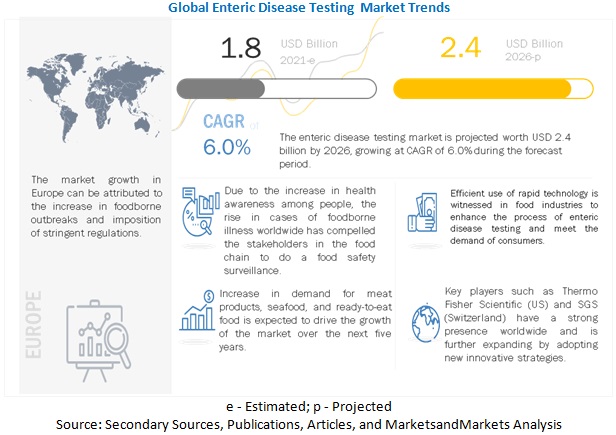The report “Enteric Disease Testing Market by Technology (Traditional and Rapid), End Use (Food (Meat, Poultry, Seafood, Dairy, Processed Foods, and Fruits & Vegetables) and Water), Pathogen Tested, and Region – Global Forecast to 2026″, The market for enteric disease testing is estimated at USD 1.8 billion in 2021; it is projected to grow at a CAGR of 6.0% to reach USD 2.4 billion by 2026. The increase in global food production impacts the food enteric disease testing market growth by increasing the number of food safety controls in each step from raw material procurement till the product reaches the consumers. Further, food manufacturers are willing to pay for testing and certification and have included this practice in their manufacturing cycles. With consumers becoming increasingly aware about the food and water-borne illnesses and stringent regulations to meet international standards, there is growing demand for enteric disease testing market.

COVID-19 Impact on the Global Enteric disease testing Market
The concern among consumers is estimated to increase for the security and safety of food products due to the outbreak of COVID-19, and this might lead to a high adoption rate for testing technologies and laboratories across the globe. Thus, the demand for enteric disease testing will increase in the coming years. Moreover, pandemic situations created due to the outbreak of COVID-19 will increase the demand for rapid tests from food manufacturers and growers to test an adequate number of samples in less time, thereby increasing the supply chain activities and enhancing the adoption of testing technologies.
Download PDF Brochure: https://www.marketsandmarkets.com/pdfdownloadNew.asp?id=139763313
Restraint: Lack of proper regulations governing pathogen testing in the developing economies
The food industry in developing countries remains highly fragmented and is predominated by small and unorganized players, who may have not necessarily adopted proper food testing practices, leading to a greater risk of contamination. The testing of food & beverage products, such as packaged foods, dairy products, beverages, and meat products, requires proper enforcement measures, coordination between market stakeholders, and supporting infrastructure. However, many countries that are classified in the cluster of developing economies lack these factors, acting as a restraint to the testing of pathogens in food and water in these regions.
Opportunity: Technological innovations in the enteric disease testing industry
Technological advancements and innovation across the supply chain have brought about a change in the way business is conducted. The focus is on reducing the lead time, sample utilization, the overall cost of testing services offered. Cheaper, faster, and efficient computing hardware coupled with improved software, network connectivity, and advanced sensors is gaining traction in the enteric disease industry.
The food segment is estimated to account for the fastest growth in the by end use segment for the enteric disease testing market.
The increase in food trade has encouraged public health and government agencies to continuously monitor food quality and take prompt actions to identify, contain, and correct sources of outbreaks. For instance, the Enteric disease and Inspection Service (FSIS) has framed regulations to control the contamination of meat & poultry products in slaughterhouses and processing plants, based on the HACCP enteric disease control system.
By technology, the rapid technology segment is estimated to account for the largest market share in the enteric disease testing market.
Rapid technology in the food industry is used to monitor the count, type, and metabolites of microorganisms that lead to food spoilage, preservation, fermentation, safety, and foodborne pathogens As the use of the Hazard Analysis & Critical Control Points (HACCP) model and other enteric disease systems have become firmly entrenched in quality assurance/quality control (QA/QC) programs, the industry’s need for “faster, better, cheaper” real-time test results has also increased.
Speak to Analyst: https://www.marketsandmarkets.com/speaktoanalystNew.asp?id=139763313
Europe is projected to be the fastest-growing market for the forecast period.
The market in this region is primarily driven by growth in the German and UK markets. It is also driven by European food policies that have been extensively emphasized by the National Reference Laboratories (NRLs) and the European Reference Laboratories (EURLs) to maintain food standards and protect consumer health. Campylobacter has been the most commonly reported food outbreak, with an increase in confirmed human cases in the European Union (EU). The market is further fueled by the presence of major enteric disease testing companies such as SGS SA (Switzerland), Eurofins Scientific (Luxembourg), and Intertek Group plc (UK), which are continuously investing and collaborating for the development of better and faster testing technologies to aid conformity to various enteric disease regulations.
